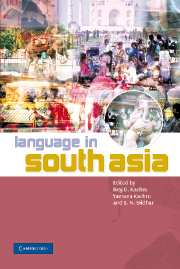Book contents
- Frontmatter
- Contents
- List of Figures
- List of Maps
- List of Tables
- Preface
- Acknowledgments
- List of Abbreviations
- Note on Transcription
- Introduction: languages, contexts, and constructs
- Part 1 Language history, families, and typology
- Part 2 Languages and their functions
- Part 3 Sanskrit and traditions of language study
- Part 4 Multilingualism, contact, and convergence
- 10 Contexts of multilingualism
- 11 Language contact and convergence in South Asia
- 12 Pidgins, Creoles, and Bazaar Hindi
- Part 5 Orality, literacy, and writing systems
- Part 6 Language conflicts
- Part 7 Language and modernization
- Part 8 Language and discourse
- Part 9 Language and identity
- Part 10 Languages in diaspora
- References
- Subject Index
- Language Index
- Author Index
10 - Contexts of multilingualism
Published online by Cambridge University Press: 04 May 2010
- Frontmatter
- Contents
- List of Figures
- List of Maps
- List of Tables
- Preface
- Acknowledgments
- List of Abbreviations
- Note on Transcription
- Introduction: languages, contexts, and constructs
- Part 1 Language history, families, and typology
- Part 2 Languages and their functions
- Part 3 Sanskrit and traditions of language study
- Part 4 Multilingualism, contact, and convergence
- 10 Contexts of multilingualism
- 11 Language contact and convergence in South Asia
- 12 Pidgins, Creoles, and Bazaar Hindi
- Part 5 Orality, literacy, and writing systems
- Part 6 Language conflicts
- Part 7 Language and modernization
- Part 8 Language and discourse
- Part 9 Language and identity
- Part 10 Languages in diaspora
- References
- Subject Index
- Language Index
- Author Index
Summary
Introduction
This chapter primarily presents the contexts of multilingualism in one major South Asian country, India. However, most of the observations made about India are applicable to multilingual contexts of other South Asian countries such as Pakistan, Bangladesh, Sri Lanka, and Nepal. India has been a multilingual country from the time of its recorded history and before. It was not a country in the geopolitical sense of being under one political authority but in the geocultural sense of having, through interaction between cultures over time, a superordinate synthetic culture with shared mythologies and beliefs that guide life. It is the plurality of cultures and the languages that codify them that define India throughout its history. It is the same plurality that continues to be the defining factor in making India into a nation in the modern period. It is a nation with no one language designated to define its nationhood. India has been functioning always, as a country in the past and as a nation in the present, in a multilingual context.
As with most countries, migration from outside was one reason for the many languages found in India, which added themselves to the languages already present. When the migrants (and invaders) became settlers, their language came to stay in the country. The new languages during historic times came in the earliest historical period from the west Asian region, in the medieval period, from the central Asian region, and in the modern, from Western Europe.
- Type
- Chapter
- Information
- Language in South Asia , pp. 223 - 234Publisher: Cambridge University PressPrint publication year: 2008
- 10
- Cited by

